Feral
RSP 10891
General Information
- Sample Name
- Merino_S_9_CSU
- Accession Date
- May 3, 2017
- Reported Plant Sex
- Female
- Report Type
- StrainSEEK v2 3.2Mb
- DNA Extracted From
- Unknown
The strain rarity visualization shows how distant the strain is from the other cultivars in the Kannapedia database. The y-axis represents genetic distance, getting farther as you go up. The width of the visualization at any position along the y-axis shows how many strains there are in the database at that genetic distance. So, a common strain will have a more bottom-heavy shape, while uncommon and rare cultivars will have a visualization that is generally shifted towards the top.
Chemical Information
Cannabinoid and terpenoid information provided by the grower.
Cannabinoids
No information provided.
Terpenoids
No information provided.
Genetic Information
- Plant Type
- Type III
File Downloads
The bell curve in the heterozygosity visualization shows the distribution of heterozygosity levels for cannabis cultivars in the Kannapedia database. The green line shows where this particular strain fits within the distribution. Heterozygosity is associated with heterosis (aka hybrid vigor) but also leads to the production of more variable offspring. When plants have two genetically different parents, heterozygosity levels will be higher than if it has been inbred or backcrossed repeatedly.
The ratio of reads mapped to Y-contigs to reads mapped to the whole Cannabis genome (Y-ratios) has been demonstrated to be strongly correlated with plant sex typing. This plot shows the distribution of Y-ratios for all samples in our database which were sequenced with the same method (panel or WGS) as this sample and where this sample falls in the distribution.
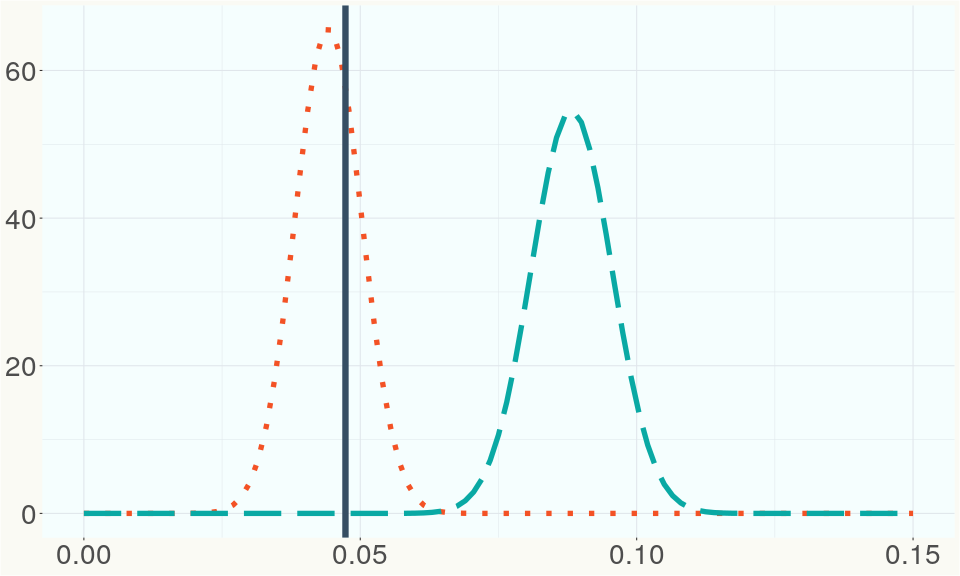
This chart represents the Illumina sequence coverage over the Bt/Bd allele. These are the three regions in the cannabis genome that impact THCA, CBDA, CBGA production. Coverage over the Active CBDAS gene is highly correlated with Type II and Type III plants as described by Etienne de Meijer. Coverage over the THCA gene is highly correlated with Type I and Type II plants but is anti-correlated with Type III plants. Type I plants require coverage over the inactive CBDA loci and no coverage over the Active CBDA gene. Lack of coverage over the Active CBDA and Active THCA allele are presumed to be Type IV plants (CBGA dominant). While deletions of entire THCAS and CBDAS genes are the most common Bt:Bd alleles observed, it is possible to have plants with these genes where functional expression of the enzyme is disrupted by deactivating point mutations (Kojoma et al. 2006).
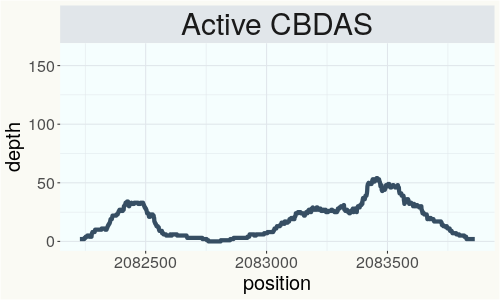
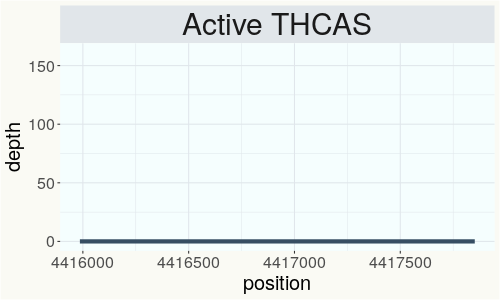
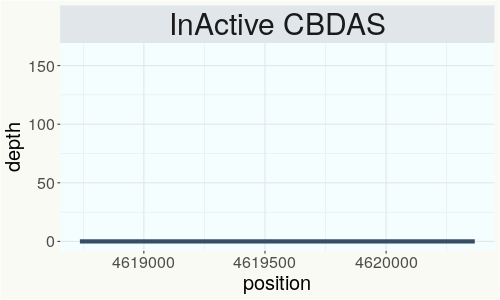
This chart represents the Illumina sequence coverage over the CBCA synthase gene.
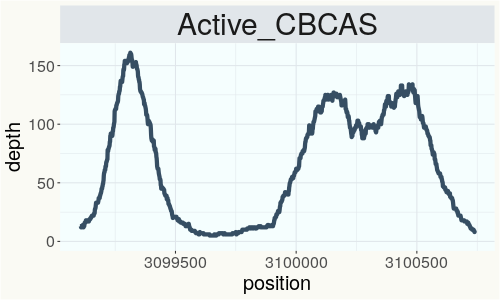
Variants (THCAS, CBDAS, and CBCAS)
Variants (Select Genes of Interest)
| GPPs1 | c.160A>G | p.Lys54Glu | missense variant | moderate | contig676 | 168409 | A/G |
|
| PKSG-4a |
c.1191_1193d |
p.Tyr398del | disruptive inframe deletion | moderate | contig700 | 1938600 | AATT/A |
|
| PKSG-2a | c.1117A>G | p.Ile373Val | missense variant | moderate | contig700 | 1944273 | T/C | |
| PKSG-2a | c.948T>G | p.Asp316Glu | missense variant | moderate | contig700 | 1944442 | A/C |
|
| PKSG-2a | c.945T>G | p.Ser315Arg | missense variant | moderate | contig700 | 1944445 | A/C |
|
| PKSG-2a | c.944G>A | p.Ser315Asn | missense variant | moderate | contig700 | 1944446 | C/T |
|
| PKSG-2a | c.934C>G | p.His312Asp | missense variant | moderate | contig700 | 1944456 | G/C |
|
| PKSG-2a | c.-2_1dupATA | start lost & conservative inframe insertion | high | contig700 | 1945632 | A/ATAT |
|
|
| PKSG-2b | c.1117A>G | p.Ile373Val | missense variant | moderate | contig700 | 1950521 | T/C | |
| PKSG-2b | c.948T>G | p.Asp316Glu | missense variant | moderate | contig700 | 1950690 | A/C |
|
| PKSG-2b | c.945T>G | p.Ser315Arg | missense variant | moderate | contig700 | 1950693 | A/C |
|
| PKSG-2b | c.944G>A | p.Ser315Asn | missense variant | moderate | contig700 | 1950694 | C/T |
|
| PKSG-2b | c.934C>G | p.His312Asp | missense variant | moderate | contig700 | 1950704 | G/C |
|
| PKSG-4b | c.544G>T | p.Gly182Trp | missense variant | moderate | contig700 | 2721129 | C/A |
|
| PKSG-4b | c.489delT | p.Phe163fs | frameshift variant | high | contig700 | 2721183 | CA/C | |
| PKSG-4b |
c.353_354ins |
p.Gly119fs | frameshift variant | high | contig700 | 2721319 | T/TGG |
|
| DXR-2 | c.1319T>C | p.Ile440Thr | missense variant | moderate | contig380 | 285250 | A/G |
|
| aPT4 | c.80A>G | p.Lys27Arg | missense variant | moderate | contig121 | 2828736 | A/G |
|
| aPT4 | c.1168T>C | p.Tyr390His | missense variant | moderate | contig121 | 2833503 | T/C |
|
| aPT1 | c.160A>C | p.Thr54Pro | missense variant | moderate | contig121 | 2835867 | A/C | |
| aPT1 | c.670T>A | p.Ser224Thr | missense variant | moderate | contig121 | 2840278 | T/A |
|
| aPT1 | c.727G>T | p.Glu243* | stop gained | high | contig121 | 2841362 | G/T | |
| HDS-2 |
c.82_93delGT |
p.Val28_Thr3 |
conservative inframe deletion | moderate | contig95 | 1989748 |
CGTAACCGGAAC |
|
Nearest genetic relatives (All Samples)
- 0.141 Feral (RSP10892)
- 0.162 Feral (RSP11205)
- 0.166 Feral (RSP10890)
- 0.231 Tisza (RSP11044)
- 0.236 Carmagnola (RSP10976)
- 0.236 Santhica27 (RSP10056)
- 0.237 Futura 75 (RSP10664)
- 0.237 Santhica 27 (RSP10665)
- 0.238 Santhica27 (RSP11047)
- 0.240 Carmagnola (RSP10979)
- 0.240 USO 31 (RSP10983)
- 0.240 Carmagnola (RSP11039)
- 0.241 Tisza (RSP11045)
- 0.243 Carmagnola (RSP10978)
- 0.243 KYRG-151 (RSP11052)
- 0.245 Kompolti (SRR14708277)
- 0.245 R1in136 (SRR14708227)
- 0.245 VIR 449 - Szegedi 9 (SRR14708213)
- 0.245 USO 31 (RSP10981)
- 0.246 Eletta Campana (RSP11209)
Most genetically distant strains (All Samples)
- 0.460 Cherry Blossom (RSP11323)
- 0.441 Cherry Blossom (RSP11328)
- 0.439 Chem 91 (RSP11185)
- 0.437 Cherry Blossom (RSP11318)
- 0.436 Cherry Blossom (RSP11301)
- 0.432 UP Wendigo (RSP11261)
- 0.428 Cherry Blossom (RSP11300)
- 0.427 Cherry Blossom (RSP11298)
- 0.426 Cherry Blossom (RSP11312)
- 0.425 Escape Velocity (RSP11165)
- 0.424 Cherry Blossom (RSP11322)
- 0.424 Motor Breath #15 (RSP12093)
- 0.424 Super Sour Diesel (RSP11191)
- 0.423 Big Bud (RSP11221)
- 0.423 JL Cross 11 (RSP11512)
- 0.423 RKM-2018-002 (RSP11093)
- 0.423 JL x NSPM1 4 (RSP11482)
- 0.421 Chematonic -Cannatonic x Chemdawg- (RSP11394)
- 0.420 Wife (RSP11148)
- 0.419 Glueberry OG (RSP11222)
Nearest genetic relative in Phylos dataset
- Overlapping SNPs:
- 120
- Concordance:
- 77
Nearest genetic relative in Lynch dataset
- Overlapping SNPs:
- 16
- Concordance:
- 13
Blockchain Registration Information
- Transaction ID
-
f35427c2771ce03c
6483690d8a2e50ce 8fbd6a9fe1852b2a d5ee7355b3fc84a2 - Stamping Certificate
- Download PDF (859.2 KB)
- SHASUM Hash
-
5f139aa2d4e65f242331d34c34b2f66d 72666b3aea549191 f0bf60c208f31a9d